Day in the life of Clicky
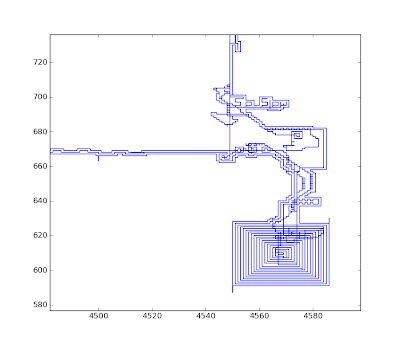 Remember
when you first learned about other planets and their many fun facts? You
were probably bombarded by such truisms as: "Jupiter is approximately
the mass of 318 Earths, has a orbital period that is 4,300 Earth days,
is made out of pure love, and is mostly transparent." Well, I was
curious about what Clicky's day was like in terms of Earth days. When
did Clicky get to sleep, when did he eat dinner, what is his orbital
radius and eccentricity? To do this, I looked at only the 3rd column of
the data that you may or may not have downloaded yesterday from
here.
Starting out, it should be noted that this is not an ordinary time
series where you have some value measured at given intervals. It is
actually a series of time points at which a click was entered. I thought
it would be most natural to go ahead and bins these to give a sense of
the access to Clicky over the past two months. It looks something like
this:
Remember
when you first learned about other planets and their many fun facts? You
were probably bombarded by such truisms as: "Jupiter is approximately
the mass of 318 Earths, has a orbital period that is 4,300 Earth days,
is made out of pure love, and is mostly transparent." Well, I was
curious about what Clicky's day was like in terms of Earth days. When
did Clicky get to sleep, when did he eat dinner, what is his orbital
radius and eccentricity? To do this, I looked at only the 3rd column of
the data that you may or may not have downloaded yesterday from
here.
Starting out, it should be noted that this is not an ordinary time
series where you have some value measured at given intervals. It is
actually a series of time points at which a click was entered. I thought
it would be most natural to go ahead and bins these to give a sense of
the access to Clicky over the past two months. It looks something like
this:
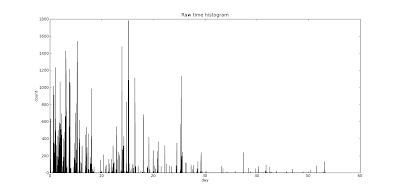 Well, that wasn't as informative as I had hoped. We see some spikes here
and there with a general trend toward neglect and abandonment towards
the end of the second month. What if we take these days and bin them
into one single day worth of traffic? We get this:
Well, that wasn't as informative as I had hoped. We see some spikes here
and there with a general trend toward neglect and abandonment towards
the end of the second month. What if we take these days and bin them
into one single day worth of traffic? We get this:
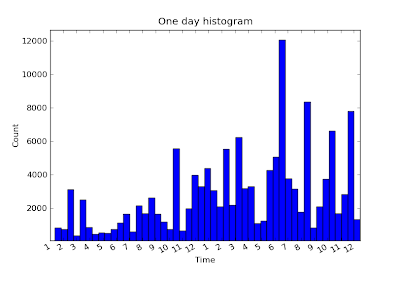 Again, not so informative yet, but we are definitely starting to see
some structure in the day. In particular, there is a lot of activity in
the afternoon and evening with a definite lull around 5pm. There is also
a distinct minima around 5am. It appears that Clicky is on the average
most active between noon and 9pm, getting a break through most of the
night.
Next, let's look at the autocorrelation of the times. For standard time
series, the autocorrelation is defined to be
$$ C_{ss}(\tau) = \int_{-\infty}^{\infty}s(t) * \bar s(t-\tau)
dt $$
which measures the amount of similarity in a signal as a function of the
time separation between two points. Again, we don't have a continuous
signal, so our autocorrelation function is instead a histogram of the
all-pairs differences in the data points that we do have. That is, start
at the first time point and subtract it from all of the other time
points in the series. Then, move to the next data point and subtract it
from all the subsequent times while keeping tracking of all of these
differences. This is our autocorrelation in real space.
Again, not so informative yet, but we are definitely starting to see
some structure in the day. In particular, there is a lot of activity in
the afternoon and evening with a definite lull around 5pm. There is also
a distinct minima around 5am. It appears that Clicky is on the average
most active between noon and 9pm, getting a break through most of the
night.
Next, let's look at the autocorrelation of the times. For standard time
series, the autocorrelation is defined to be
$$ C_{ss}(\tau) = \int_{-\infty}^{\infty}s(t) * \bar s(t-\tau)
dt $$
which measures the amount of similarity in a signal as a function of the
time separation between two points. Again, we don't have a continuous
signal, so our autocorrelation function is instead a histogram of the
all-pairs differences in the data points that we do have. That is, start
at the first time point and subtract it from all of the other time
points in the series. Then, move to the next data point and subtract it
from all the subsequent times while keeping tracking of all of these
differences. This is our autocorrelation in real space.
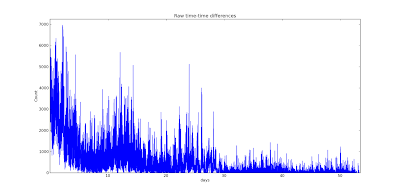 We can also zoom in and smooth the data a bit
We can also zoom in and smooth the data a bit
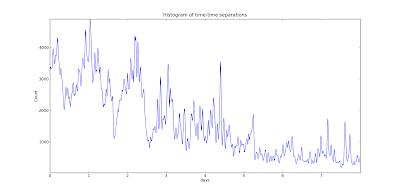 Ah,
now there we go. We see a distinct over-abundance of time differences
around 1 day, 2 days, etc. What is the primary oscillation we see in the
correlation? To see that, let's look at the frequency space
autocorrelation and plot its power, or square.
Ah,
now there we go. We see a distinct over-abundance of time differences
around 1 day, 2 days, etc. What is the primary oscillation we see in the
correlation? To see that, let's look at the frequency space
autocorrelation and plot its power, or square.
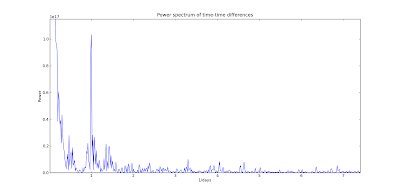 Finally,
we get the primary component of the variation of Clicky's visits
throughout the 2 month period that he was in operation. It occurs, to
within error, at 1 day. No very surprising at all. I'm sure we could
look more closely at the peak and its width, but I am satisfied to say
that Clicky's day is defined by the Earth day to within a few percent.
*In response to more messages in Clicky, we agree that it is "So slow."
Rest assured, management is looking into the problem.
Finally,
we get the primary component of the variation of Clicky's visits
throughout the 2 month period that he was in operation. It occurs, to
within error, at 1 day. No very surprising at all. I'm sure we could
look more closely at the peak and its width, but I am satisfied to say
that Clicky's day is defined by the Earth day to within a few percent.
*In response to more messages in Clicky, we agree that it is "So slow."
Rest assured, management is looking into the problem.
Comments
Comments powered by Disqus